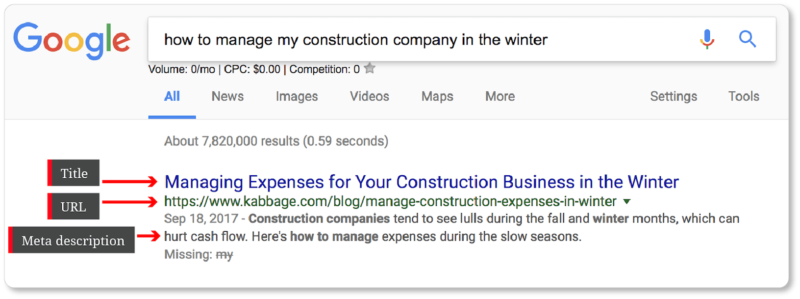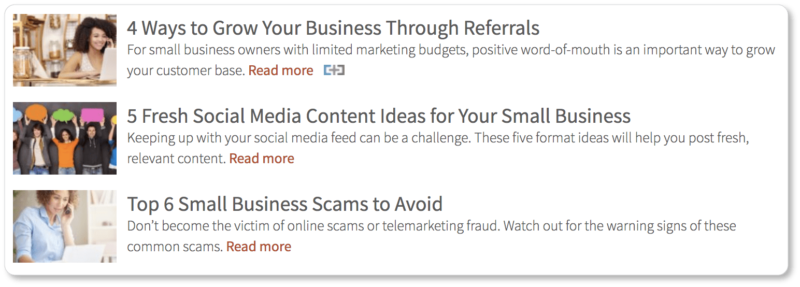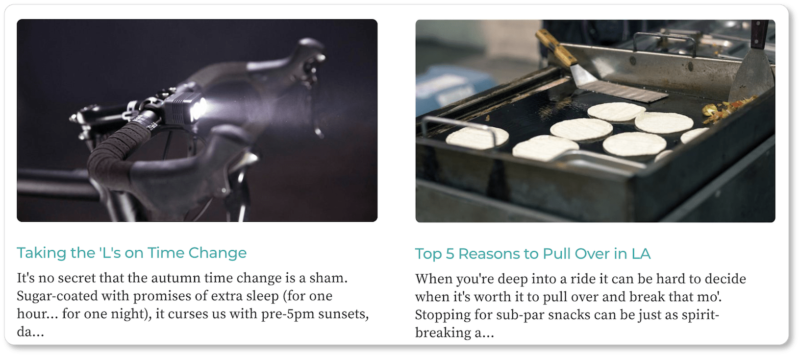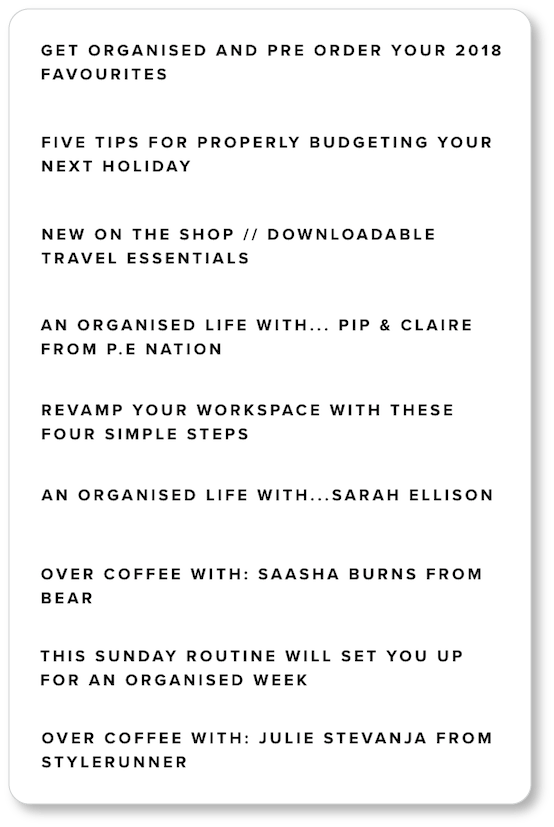 As we’ve discussed, your blog content will need to be a delicate balance of two things: prospect-benefitting content and search engine optimization. In other words, your blog content should be search-engine-friendly enough that your prospects can find it; but compelling and educating enough that they stay on your site once they get there.
As we’ve discussed, your blog content will need to be a delicate balance of two things: prospect-benefitting content and search engine optimization. In other words, your blog content should be search-engine-friendly enough that your prospects can find it; but compelling and educating enough that they stay on your site once they get there.
Of these two concerns, the latter—your investment in your readers—should be your priority. In this section, we focus on that investment. Here’s how to approach your content with your readers in mind:
Write descriptive and compelling titles
We’re probably telling you something you already know here; but in case we’re not, it’s indispensable advice.
Your readers’ first impression may be their only impression. Remember that a prospective reader won’t see much more than the title of your blog post—along with the URL and meta description—on a search engine results page:

So if the title doesn’t compel, nobody is going to click through—no matter how great the rest of the content is.
Your title should not only pique interest; it should also accurately describe what the post is about, so that a searcher won’t be frustrated or feel misled once they click in. The blog post at the small business loan company Kabbage gives us precisely what its title promised in the results page above:

Don’t settle for your first title idea. Write down ten, fifteen, twenty-five possibilities. And once you’ve finished drafting the post, go back again and see if you can add to the list. Make this an exhaustive process.
Numbered lists (or “listicles”), “how-tos,” and question-based titles don’t seem to be going out of style anytime soon. (The bloggers at Manta, for example, recognize the power of the listicle, while the bloggers at Sleeknote appear to prefer the “how-to” post):


Copyblogger’s Sure-Fire Headline Formulas, HubSpot’s How to Write Better Headlines infographic, and BizMSolutions’ 30 Social Media Headline Formulas are valuable places to start. But you should also start paying attention to the blog titles that grab you when you’re surfing the web, or to the magazine headlines that grab you in the checkout line at the grocery store.
Here are some excellent blog title examples from the payroll and HR company Gusto:

Notice how Gusto strives for variety in its post titles. It offers a listicle (“5 of the Most Awkward Work Situations”), a “Beginner’s Guide,” a case study (“This Successful Studio Converted 50 Contractors to Employees”), an answer to a standalone question (“How You Set Up a Meaningful Internship Program”), and the always-effective “Secret Formula” title.
Pro tip: Provocation shouldn’t end at the title. The first few sentences of your post will determine whether visitors stay or click out… you’ve got THAT much time to keep their interests piqued. What’s more, those first few sentences matter so much because—depending on the limitations of your CMS—you may only be able to display the opening sentences, rather than a chosen excerpt, on your blog’s homepage.
We can’t say whether the bloggers at Pure Cycles are working under such limitations, but their blog’s homepage does only display the first sentences of every post. Luckily, they’ve written some compelling opening sentences in each one:

Base it on a keen awareness of your audience and its needs
You’re not writing your blog for your peers, and you’re ultimately not writing for the search engines. You’re writing for your customers and prospects. Consider their desires, fears, problems, and challenges, and address these consistently in your content.
The 80/20 rule of content marketing is worth keeping in the back of your head with every blog post you write. While 20% of your content can be related to your product and to promoting your company (and even then, don’t be salesy!), the other 80% should be educative, relevant to your prospects’ pain points more broadly, and committed to offering both explorations of their values and solutions to their challenges.
Remember the example of The Organised Life blog we used in the last section? Note that only one of the nine blog titles—”Get Organised and Pre Order Your 2018 Favourites”—is an explicit sell:

Make it better than your competition’s
There are well over 440 million blogs on the internet today—and your competitors’ blogs are among them. You want to outclass these blogs.
Each time you sit down to write a new post, enter the keywords you’ve chosen for it into Google and see who’s ranking for them. Then go to the top returns in the results pages and analyze their content. Another strategy is to go directly to the blogs of the most successful businesses in your industry. Take a look at what they’re doing, then come up with something better than what you read, with more value, more resources, more multimedia—in a word, more authority.
Write it in your own voice
Your business blog is an ongoing project. Whether you return to it daily, weekly, or biweekly, the point is that you’ll be returning to it often. You’ll only exhaust yourself if you go into “performance mode” every time you sit down to write. You’ll start dreading the time you set aside for blogging… and sooner than later, your blog will end up at the bottom of your priority list.
So make your blog a part of the colloquial, informal conversation you’re already having with your customers on a daily basis. Your readers want your real, natural, unique human voice. You’re solving their problems, after all; and the relationship you’re building with them is already intimate. So speak with them (or, rather, write to them) as though that’s true. Be funny, authentic, self-deprecating, and human. You’ve made mistakes. You have opinions. You have stories to tell. Share them.
Bob Borson at Life of an Architect is a remarkable example of a blog that’s found its voice:
If you’re initially having trouble finding your own voice—or if you tend to go into “formal mode” as soon as you start writing—try these tips:
- Talk out loud as you write. (You might even record yourself on your phone or with a speech-to-text application.)
- Go into your email correspondence and look at how you write to the customers and clients you’re more intimate with. (Don’t search for the ones you’re most intimate with: Those conversations may be too casual and jargony. You’re going for a voice that’s “becoming-intimate.”)
- Look at how those customers write to you. The language you use in your posts should mirror how they speak and the words they use—not your employees’ specialized language or the industry’s language at large.
- Pay attention to the way you talk about what you do with people who aren’t in your industry. Maybe you even have someone in your life who’d be willing to listen to you “talk out a blog post” once in awhile. This will help you organize the order in which your post offers its information; but it will also ensure that you keep your post more colloquial than stiff and formal.
Make it accurate and error-free
Your blog content is fulfilling your prospects’ or customers’ need for information and offering solutions to their problems. This necessarily means that your posts should be well-researched. When you quote a statistic, find the original source. When you quote studies, find the most recent numbers and results. You want your users to see you as a trusted authority… so fact-check your content.
Along the same lines, sloppy, poorly-edited content is damaging to your reputation, so always double- and triple-check your posts for spelling and grammatical errors. If it helps, print it out and proofread it on paper. Then give it to someone else to proofread before you go back in again and hit “publish.”
Keep it easy on the eyes
Use short paragraphs, numbered lists, bullet points, bold text, and lots of white space (as well as images and video) so your reader can scan and digest your content more easily.
Go long when you can
According to HubSpot, there’s a “sweet spot” for blog post length, and it’s in the 2,250-2,500 word range. HubSpot also observes that posts longer than 2,500 words are the posts most often shared on social media and that earn the most backlinks (inbound links). What’s more, search engines have a preference for long-form content, and will always give more authority to longer blog posts than to shorter ones (assuming, of course, those long posts are also packed with great content).
That’s not to say don’t publish short posts. You’ll have a goal in mind for every post you publish, and sometimes that goal will simply be to offer your reader a great piece of advice or an anecdote for the day. We’re just suggesting that you consider the data, and don’t make short posts a regular habit.
Post frequently
Here are some facts worth considering, again thanks to HubSpot:
- Businesses that publish 16 or more blog posts a month receive almost 3.5 times more traffic than those that publish 0-4 posts a month.
- Businesses that publish 16 or more blog posts a month receive about 4.5 times more leads than those that publish 0-4 posts a month.
- Businesses that have published over 400 blog posts get about twice as much traffic as those that have published between 301 and 400 blog posts.
- Businesses that have published over 400 blog posts get over 3 times more leads than those that have published between 0 and 100 blog posts.
These stats should answer any questions you may have had about the benefits of frequent blogging.
Search traffic naturally increases the more often you blog, because each blog post is another indexable page from a search engine perspective. But blogging often does more than just increase organic search traffic. It also generates leads. And, from an audience perspective, it keeps your readers happily coming back for more on a regular basis.
We know. You’ve got a lot of things to juggle when you’re running a business. This is why it may help to have more than one writer on your team, or to hire a freelance blogger to keep the words coming when you can’t.
Our recommendation is to create an editorial calendar and implement a routine publishing schedule. The calendar will allow you to see a month (or more) ahead of you, and to map out the topics you want to tackle in your blog posts in the near future. (That said, you might consider giving yourself one “free” day in the week where you can write about current events in your industry. Don’t remain so steadfast to your calendar that you let important developments pass you by without commentary.)
Mapping out your topics ahead of time will also allow you to better see the big picture. Ideally this will lessen any anxiety you might have about all the blog posts you’ll be publishing within a given time frame.
There are plenty of tools out there to help you track content creation, ranging from simple spreadsheets, to calendar tools (such as Google Calendar or Zoho Calendar), to project management tools (such as Zoho Projects and Basecamp).
You’ll choose the project management system that works best for your business based on the number of bloggers you have writing for you, the regularity with which you decide to publish, and the complexity of the blog posts you’re planning.
If you’re doing the blogging for your own business, try to set aside a regular window—whether it’s every Sunday night after you’ve had the weekend to let thoughts simmer, or the first half-hour of every work day—to sit down and think about nothing but the blog. Be reasonable about the time you allot to blogging, or else you’ll give up on yourself within a matter of days.
If you stay consistent about your publishing schedule, there’ll come a time when your regular readers begin to expect content from you on the day—and maybe even at the hour—you normally hit the “publish” button. This will often be incentive enough to stay on schedule.
Pay attention to analytics
… as much for your readers’ sakes as for your own. Your CMS or website builder should have some sort of analytics feature built in already. For example, Zoho Sites has traffic analytics by default; users can easily add Google Analytics or similar tools to track more advanced analytics.
 Monitoring your blog analytics will alert you to what themes and topics are resonating with your audience. It will also tell you how many people read each post, where those users came from (for example, organic search or social), whether they viewed multiple blog posts or just one, how long they stayed on your blog, how many of them clicked into other pages of your website, and so on.
Monitoring your blog analytics will alert you to what themes and topics are resonating with your audience. It will also tell you how many people read each post, where those users came from (for example, organic search or social), whether they viewed multiple blog posts or just one, how long they stayed on your blog, how many of them clicked into other pages of your website, and so on.
These metrics will provide valuable insights about the performance of your blog content, and where you have room for improvement. If your visitors are only viewing one page, you’ll want to consider adding more internal links or additional calls to action. If you notice that the posts that get the most reads are those published on Monday mornings, that’s when you should aim to publish regularly.
Perhaps most importantly, if a select few posts have gotten a lot of traffic over time, those are the ones worth updating and republishing. You may even create more content on the subjects those popular posts cover, since obviously the topics are in high demand. Remember, the posts that you’re most excited about may not be the same posts your readers are raving about. Give them what the analytics say they’re asking for.
So now you know what “killer blog content” entails—and you know you need to create it frequently. But surely you’ll run out of things to write about eventually, right? In the next section, we offer a list of strategies to help you generate blog ideas in the weeks you feel you’re lacking material—or inspiration—for your business blog.



